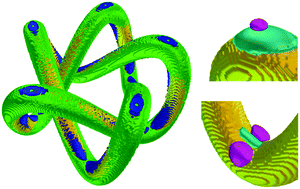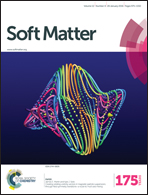Relevance of saddle-splay elasticity in complex nematic geometries†
Abstract
We demonstrate the relevance of saddle-splay elasticity in nematic liquid crystalline fluids in the context of complex surface anchoring conditions and the complex geometrical confinement. Specifically, nematic cells with patterns of surface anchoring and colloidal knots are shown as examples where saddle-splay free energy contribution can have a notable role which originates from nonhomogeneous surface anchoring and the varying surface curvature. Patterned nematic cells are shown to exhibit various (meta)stable configurations of nematic field, with relative (meta)stability depending on the saddle-splay. We show that for high enough values of saddle-splay elastic constant K24 a previously unstable conformation can be stabilised, more generally indicating that the saddle-splay can reverse or change the (meta)stability of various nematic structures affecting their phase diagrams. Furthermore, we investigate saddle-splay elasticity in the geometry of highly curved boundaries – the colloidal particle knots in nematic – where the local curvature of the particles induces complex spatial variations of the saddle-splay contributions. Finally, a nematic order parameter tensor based saddle-splay invariant is shown, which allows for the direct calculation of saddle-splay free energy from the Q-tensor, a possibility very relevant for multiple mesoscopic modelling approaches, such as Landau-de Gennes free energy modelling.

- This article is part of the themed collection: Open access articles from Soft Matter

 Please wait while we load your content...
Please wait while we load your content...